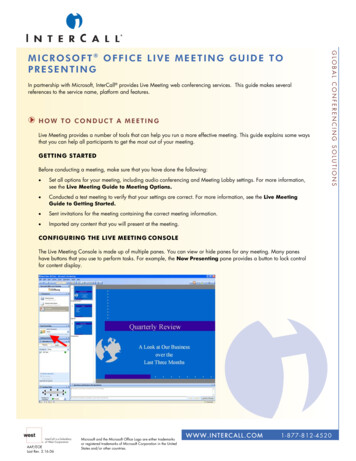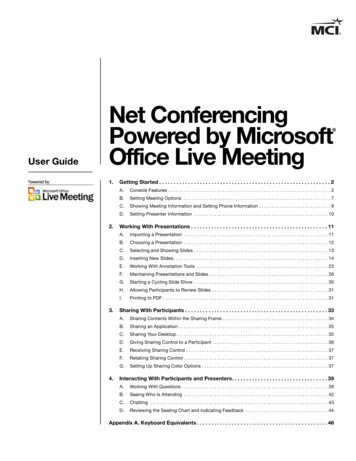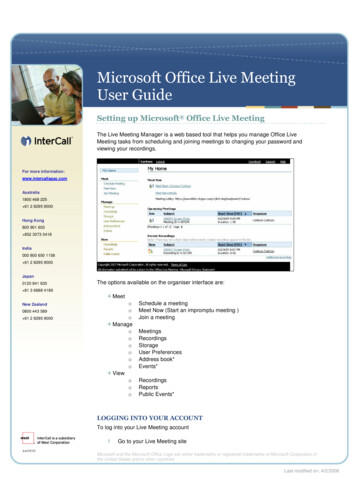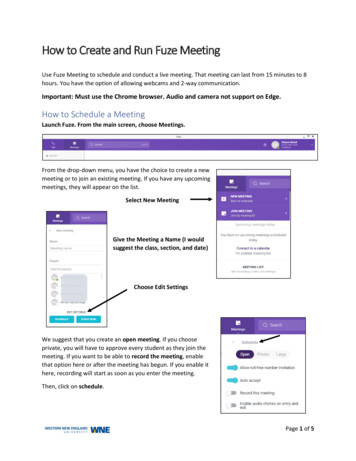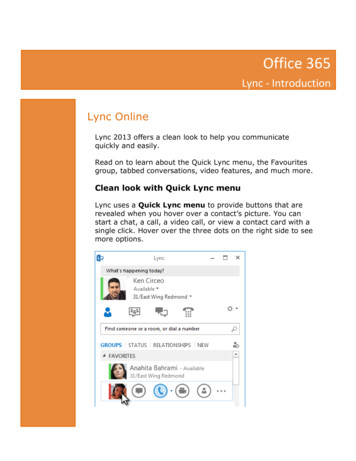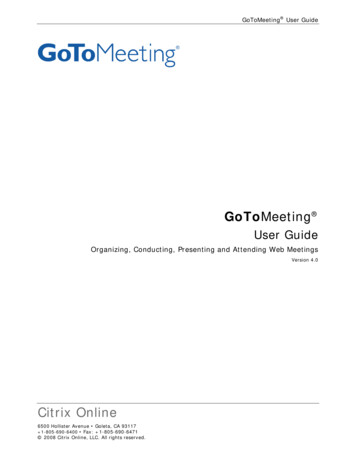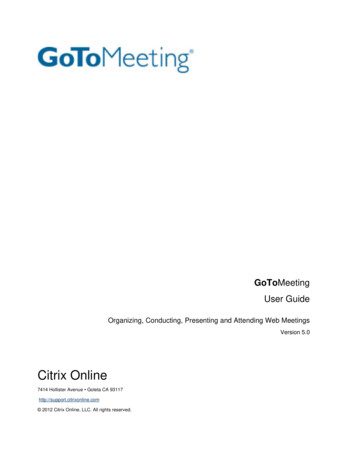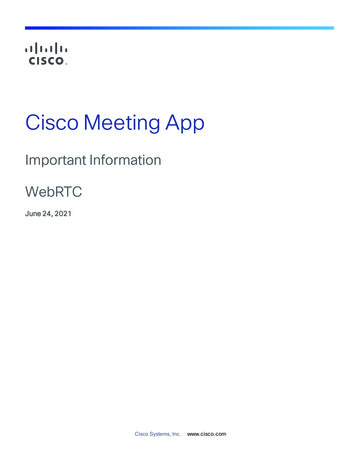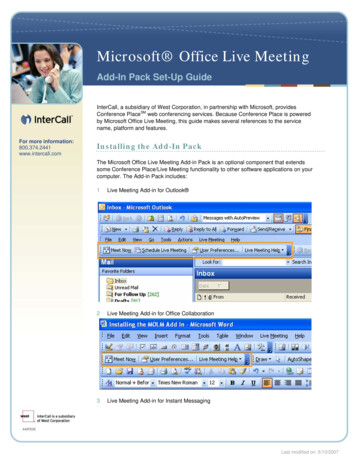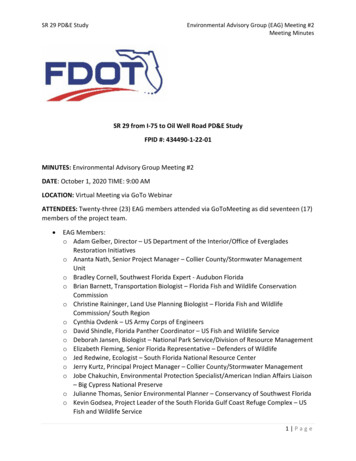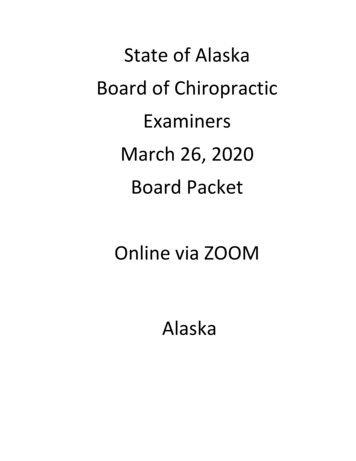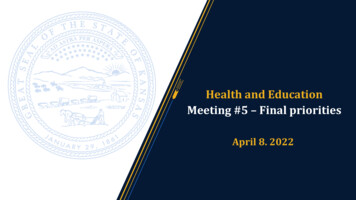
Transcription
Health and EducationMeeting #5 – Final prioritiesApril 8. 2022
Agenda1Overview: Purpose of today, where we are in the process, what's next (10 mins)2Review: Final program prioritization and investment strategies (10 min)3Align: Portfolio recommendation for Executive Committee (80 min) 4Discuss: Final funding for portfolio recommendation (10 min)5Next Steps: Preparation for Executive Committee meeting (10 min)1
Confidential & Preliminary - Not for DistributionWhere we are & objectives for todayObjectives for todayAdvisory Panel Research onbrainstormother pertinputCommunityinput 200Note: Investment ideas gatheredvia a consistent submission form1Broad list of ideasFiltering lens 1002ideasLong list assessedPrioritization lens 25Advisory Panel priority programsSubset of program areas prioritizedbased on impact and feasibility4Subset of Advisory Panel priorityprogram areas selected forrecommended SPARK investmentportfolio based on delivery of coreobjectives and collective impactObjectives lens 7-10Recommended for SPARKinvestment portfolioWe are hereFilter long list of ideas based on: Allowability Alternate funding Existing program Funding scale3Short list prioritizedfor deep diveSPARK portfolio programsLong list of ideas compiled based on: Advisory Panel inputs SME / agency inputs Public testimony Best practices from other places1 Review final programprioritization anddiscuss potentialinvestment strategies2 Review portfoliorecommendation anddetermine minimumand target scenarios3 Finalize portfoliorecommendation forthe SPARK committee2
Confidential & Preliminary - Not for DistributionRecall Meeting #5 is the last meeting to reach the final Build sharedunderstanding ofcurrent needs &opportunities inKansas315Initial ionPortfolio sizing &recommendationPreview themes fromidea submissions andbrainstorm solutionswithin focus areasReview filtered longlist of submissionideasNarrow and prioritizepotential portfolioconsidering coreobjectives, impact,feasibility, andparametersAlign on panel'spriorities forminimum and targetfunding scenariosand defined SPARKrecommendationwith associated ideas1Align on investmentthemes for buildoutIdeafilteringprocess4Consider & shapeprogrammatic areasfor investmentFiltering lens 250 Broad list of ideasPrioritization lens 130 Long list assessedObjectives lens 8 programs for deep-diveAdditional detail on idea submissions associated with programs will be communicated as part of the program reports provided to the SPARK Executive CommitteeTBD recommended13
Confidential & Preliminary - Not for DistributionHow we're building towards the Health and Education SPARK fundingrecommendationDeveloping our portfoliorecommendationMeeting 4 Finalize program shape (scope,impact, feasibility) Set program parameters to guideselection of projects post-SPARKprocess Share no. of idea submissions andassociated in line with program1Mtg 4Health & Ed. SPARKFunding Recommendation Prioritize & force rank programs viaallocation exercise Provide input on minimum & targetfunding, program shape & revisit rankingPortfolio Recommendation Key messages for theExecutive Committee Rate idea submissions within scope ofdefined programs for fit with programparameters Finalize priorities for minimum andtarget funding scenarios for programs,building on idea submissions1 Discuss key messages for the ExecutiveCommitteeToday's focus Shape programmatic areas,considering idea submissions, panel &SPARK guiding principles and prioritize 8 programmatic areasHomework Discuss overarching focus areas andneeds in Health and EducationMeeting 5Meetings 1-3Defining our programsAdditional detail on idea submissions associated with programs will be communicated as part of the program reports provided to the SPARK Executive CommitteeFinal view of aggregated portfolioto be finalized by the ExecutiveCommittee4
Confidential & Preliminary - Not for DistributionRecall Principles guiding investmentSPARK Guiding Principles Prioritize sustainable programs & investments throughone-time use of funds vs substantial expansion ofexisting services Combine with / leverage local and agency funds tomaximize use of discretionary funds Foster long-term systemic impact for Kansans Consider equitable opportunities and outcomes Enable flexibility within investment strategies (e.g., incase of emerging needs, changing federal landscape)Health and Education Panel Principles Investments should build on proven interventionsand expert recommendations Investments should be made in areas that havelargely allowable programs where existing funding isinsufficient and limited Investments should support state-wide, long-termtransformation (vs. short term solutions) Investments should avoid establishing programsrequiring ongoing funding (e.g., new long-termbudget items) Ensure results are measurable to enable tracking &transparency5
Agenda1Overview: Purpose of today, where we are in the process, what's next (10 mins)2Review: Final program prioritization and investment strategies (10 min)3Align: Portfolio recommendation for Executive Committee (80 min) 4Discuss: Final funding for portfolio recommendation (10 min)5Next Steps: Preparation for Executive Committee meeting (10 min)6
Confidential & Preliminary - Not for DistributionInputExecutive Committee OutputProgram input survey(Meeting 4 homework)Various inputs haveshaped our finalfunding portfoliorecommendation forSPARKProgram reports, with final portfolio ofprioritized programs and respective fundingIdea submissions rating excel(Meeting 4 homework)List of high-fit idea submissions for eachrecommended programLive discussion inMeetings 4 and 5Understanding of Panel's prioritization andrefinement to program report language 7
Confidential & Preliminary - Not for DistributionPanel has conducted 100-point allocation exercise and individualprioritization to help triangulate target and minimum funding scenariosProgram areaHow would you allocate 100points across these programs?How would you prioritize theseprograms?N 5; % of points allocated(from live Meeting #4 discussion)1N 3; Ranking scale of 1-8, 8 ishighest (from Meeting #4 homework)Health facilities or program expansion20%Workforce pipeline developmentAvg: 716%Targeted supportive housing & emplymt.Avg: 512%Community based resources & nav.Avg: 629%Avg: 4Child care capacity accelerator8%Avg: 5Telehealth adoption & utilization7%Avg: 4Home visiting services4%Avg: 2Early childhood data integrationand systems enhancements3%Avg: 21.2.Allocation shows aggregated view of 5 panelists anonymous submissions during a live exercise in Meeting #4Panelists individual rankings have been anonymized and shown in light grayObservationsHealth facilities orprogram expansion,workforce pipelinedevelopment andtargeted supportivehousing employment arehigh priority areasPanel has mixed viewson community-basedresources and navigationand child care capacityaccelerator8
Confidential & Preliminary - Not for DistributionN 6 panelistsInitial starting point for funding asks will be discussed and finalized during Meeting #5Strawman investment strategy based on Panelist input, ordered by Panel prioritization# of High-FitSubmissions M Associated22Workforce pipeline developmentProgram areaHealth facilities or program expansion 287MMinimum Ask 25MTarget Ask 75M7 20M 25M 50MTargeted supportive housing & emplymt.8 38M 25M 75MCommunity based resources & nav.11 71M 20M 40MChild care capacity accelerator19 96M 25M 50MTelehealth adoption & utilization5 11M 5M 10MHome visiting services0 0M 5M 7MEarly childhood data integration6 4M 5M 8MOther1 4M--79 530M 135M 315MTotal3 ideas suggested by panelists to include that do not fallwithin current program scopes, 1 rated as High-FitAbove funding scenario rangeWithin funding scenario rangeBelow funding scenario rangeNote: sum of rows may not equal totals due to roundingNote: Minimum and target asks represent preliminary, illustrative scenarios based on top-down sizing (program scope and need, 100-point9exercise, benchmarks) and bottom-up input (idea subs.). Scenarios will be a focus of today's discussion and adjusted to reflect panel input
Confidential & Preliminary - Not for DistributionIllustrativePanel can consider variety of investment strategies to determine funding recommendationInvestment strategy #1: Distributed across programsInvestment strategy #2: Big BetsAllocate funding across all programs based on prioritiesSelect fewer priority programs, increase funding for target askProgram areaMin.TargetProgram areaMin.Program #1 25M 50MProgram #1 25M 100M 50MProgram #2 25M 50MProgram #2 25M 100M 50MProgram #3 20M 30MProgram #3 20M 30MProgram #4 10M 25MProgram #5 10M 25MProgram #4 10M 25MPrograms deprioritized & not recommended for fundingProgram #5 10M 25MProgram #6 10M 20MProgram #6 10M 20MTotal 100M 200MTotal 50M 200MMin. ask remainsconstant, reducingoverall funding ask1Are there any other investment strategiesthe panel should discuss and consider?2TargetIncrease to targetTarget ask for keyprograms increasedby 50%Given limited funding and current priorities, what investmentstrategy do you think is most optimal for the panel to use?10
Confidential & Preliminary - Not for DistributionIllustrativePotential portfolio investment strategies for Health and Education programsInvestment strategy #1: Distributed across programsInvestment strategy #2: Big BetsAllocate funding across all programs based on prioritiesSelect fewer priority programs, increase funding for target ask 75MProgram areaTargeted supportive housing & emplymt.Min. 25MTarget 94MIncreaseto target 19M 25M 75MHealth facilities or program expansion 25M 94M 19MWorkforce pipeline development 25M 50MWorkforce pipeline development 25M 63M 13MChild care capacity accelerator 25M 50MChild care capacity accelerator 25M 63M 13MCommunity based resources & nav. 20M 40MCommunity based resources & nav. 20M 50M 10MTelehealth adoption & utilization 5M 10MTotal 120M 363MEarly childhood data integration 5M 8MHome visiting services 5M 7M 135M 315MProgram areaMin.TargetTargeted supportive housing & emplymt. 25MHealth facilities or program expansionTotalHealth1EducationMin. ask remainsconstant, reducingoverall funding askTarget ask for keyprograms increasedby 25%Health and educationDo either of these approaches resonatewith the panel?2Do you agree with the total envelope size?3What is the right mix of funding forhealth vs education programs? 11
Agenda1Overview: Purpose of today, where we are in the process, what's next (10 mins)2Review: Final program prioritization and investment strategies (10 min)3Align: Portfolio recommendation for Executive Committee (80 min) 4Discuss: Final funding for portfolio recommendation (10 min)5Next Steps: Preparation for Executive Committee meeting (10 min)12
Confidential & Preliminary - Not for DistributionToday's discussion is focused on finalizing the portfolio recommendation summary;opportunities in upcoming homework for offline review of Executive Committee outputsMaterials to be shared with the Executive Committee1Portfolio recommendationChairs to present to Exec Committee 4/18Finalize minimum and targetfunding scenarios in Meeting #52Program reportsFor offline review by Exec CommitteeOverview shared today, to be sharedback with panelists for offline review3Idea submission ratingsFor offline review by Exec CommitteeOverview shared today, to be sharedback with panelists for offline reviewFocus of today's discussion13
Confidential & Preliminary - Not for DistributionHealth and EducationInvestment Program Health facilities or program expansionNote: Funding asks represent early, top-down illustrations of what different funding levels might achieve as oneinput for panelists while considering potential funding envelopesProgram DescriptionStatewide grant program to close service gaps in the continuum of care via investing in health facilityinfrastructure or programs to expand innovative care models and treatment programs. Eligible projects includefacility dev. or renovation or program dev. Eligible applicants include hospitals, CBO's or care providersGoals / Target OutcomesFocus Areas: Behavioral health, health,disability services, senior servicesNeed: Availability & affordabilityAlignment to SPARK Guiding Principles Sustainable program & investment Local / agency funding opportunity Long-term systemic impactIncrease access to services, improve health outcomes by providing support earlier in continuum of care , decreasewaitlist for services , lower healthcare system costs by delivering care in lower cost settings and enabling moretimely dischargeTarget Ask: 75MPreliminaryFor inputAssumes funding split 50/50% across health facilitiesinfrastructure and innovative care and treatment 8 health facilities infrastructure projects( 37.5M), e.g. expansion or renovation, 5M each 11 innovative care models and treatment projects( 37.5M), 3.3M eachMinimum Viable Ask: 25MPreliminaryFor inputAssumes funding split 50/50% across facilitiesinfrastructure and innovative care and treatment 3 health facilities infrastructure projects ( 12.5M),e.g. expansion, renovation, 5M each 4 innovative care models and treatment projects( 12.5M), 3.3M each Equitable opportunities and outcomesAdditional Impact & Feasibility DetailsAdditional Considerations Flexible investment strategy Impact:– Addresses statewide shortages of health services– Long-term expansion of facilities, near-term impactvia innovative care delivery support– Promotes equity by targeting high-needscommunities High-fit idea submissions:– Transitional living program for foster youth who havebeen incarcerated (4 ratings)– Behavioral health urgent care clinic dev. (3 ratings) Allowability considerations– Path to allowability Other funding sources & programs:– SAMHSA (high needs beh. health/disability pop. only),KanCare (services only) Interdependencies:– Workforce pipeline development investments in14Health and Education / Economic Revitalization Measurable outcomesImpact: HighFeasibility: Medium Feasibility:– Builds on existing health services, partnerships andextensive agency experience– One-time investment in facilities / renovation or forinnovative service delivery; potential for partnershipsto support ongoing costs
Confidential & Preliminary - Not for DistributionNote: Funding asks represent early, top-down illustrations ofwhat different funding levels might achieve as one input forpanelists while considering potential funding envelopesProgram funding discussion Health facilities or program expansionProgram scope Health facility infrastructure, e.g.,– Community outpatient providers (e.g., CMHCs)– Long-term inpatient providers (e.g., step-up / down)– Hospitals (e.g., emergency department)– Medical education centers Innovative care models and treatment programs (e.g.,pilots & targeted program expansion)Funding considerationsMinimum ask: 25M 3 health facilities infrastructure projects ( 12.5M),e.g. expansion, renovation, 5M each (mediansubmission) 4 innovative care models and treatment projects( 12.5M), 3.3M each (median submission)Target ask: 75M Health facility infrastructure: 12K - 80M, withmedian request of 5M 8 health facilities infrastructure projects ( 37.5M),e.g. expansion or renovation, 5M each (mediansubmission) Innovative care models and treatment: 300K 56M, with median request of 3.3M 11 innovative care models and treatment projects( 37.5M), 3.3M each (median submission)Funding amounts from idea submissions varied significantly:Source: Idea submissions – Project values based on median funding amount per project from idea submissionsIs this the right funding envelope? If not, what does the panel recommend for this program?15
Confidential & Preliminary - Not for Distribution# of "High" ratings # of submissions M Associated41 3.0M33 7.4M29 31.7M19 245.0MTotal22 287.1MHigh-fit submissions Health facilities or program expansion (I/III)Program parametersHigh-fit submissions Prioritize one-timeinvestments, or those withplan in place for ongoing costs(e.g., partners, federalfunding)Submission – Submitting entity Prioritize investments thataddress service gaps in thecontinuum of care, with clearimpact / ROI metrics Prioritize investments thattarget high-needscommunities (by geography,by population demographics) Ensure recipients havesufficient workforce in placeto achieve target impact Associated# of "High" ratingsStrengthen behavioral health services to ensure long-term stability andeconomic opportunity for foster children - Cornerstones of Care 3.0M4Behavioral Health Urgent Care Clinic - Central Kansas Mental HealthCenter (CKMHC) 1.0M3Certified Community Behavioral Health Clinic Capacity Grants - Associationof Community Mental Health Centers of Kansas 5.2M3Youth Crisis and Recovery Center Building - Family Service and GuidanceCenter of Topeka 1.2M3Crisis Intervention Team Unit - City of Topeka 1.5M2Perfect Fit Therapy Clinic - Perfect Fit Foundation and Therapy Clinic 1.5M2Pediatric Hospital to Home Transition and Sustainment Program - CraigHomeCare .6M2Expand SB 123 Administrative Platform to include 2021 HB 2026 DiversionDrug Treatment Program - Kansas Sentencing Commission .3M2Program of All-Inclusive Care for the Elderly (PACE) program expansion Midland Care Connection 2.5M2Improve discharge process from NFs and NFMHs - KDADS 20.0M2 .9M2Low Vision Mobile Training & Rehabilitation Pilot Program - Envision Inc.Note: Based on input from 6 Panelists; all submissions rated as 'high fit' will be shared with Executive Committee16
Confidential & Preliminary - Not for Distribution# of "High" ratings # of submissions M Associated41 3.0M33 7.4M29 31.7M19 245.0MTotal22 287.1MHigh-fit submissions Health facilities or program expansion (II/III)Program parametersHigh-fit submissions Prioritize one-timeinvestments, or those withplan in place for ongoing costs(e.g., partners, federalfunding)Submission – Submitting entity Prioritize investments thataddress service gaps in thecontinuum of care, with clearimpact / ROI metrics Prioritize investments thattarget high-needscommunities (by geography,by population demographics) Ensure recipients havesufficient workforce in placeto achieve target impact Associated# of "High" ratings 4.0M2 .4M2Community Care Options Preservation Fund - KHCA/KCAL (Kansas) 55.5M1Sedgwick County COMCARE Community Crisis Center Expansion Sedgwick County 24.0M1 1.0M1 2.7M1 21.4M1Capital Health Investment to Increase Access to Care Provided by Statefunded Clinics - Community Care Network of Kansas 80.0M1Capacity expansion for behavioral health system of care - KDADS 50.0M1Implement a Sustainable, Accessible, and Integrated System of Care forThose With Mental Health Issues and Substance Use Disorders - MentalHealth and Substance Abuse CoalitionFund Language Assessment Program (LAP) for one year whilesustainability efforts of the program are underway - KDHEEMS Equipment Assistance Grant - Kansas Emergency Medical ServicesBoardPartnering together to Provide Medical Attention and MedicalPrescriptions to Kansans - Mercy and Truth Medical Missions inpartnership with Pharmacy of GraceSt. Joseph Campus ED Expansion/Remodel - Ascension Via ChristiHospitals Wichita Inc.Note: Based on input from 6 Panelists; all submissions rated as 'high fit' will be shared with Executive Committee17
Confidential & Preliminary - Not for Distribution# of "High" ratings # of submissions M Associated41 3.0M33 7.4M29 31.7M19 245.0MTotal22 287.1MHigh-fit submissions Health facilities or program expansion (III/III)Program parametersHigh-fit submissions Prioritize one-timeinvestments, or those withplan in place for ongoing costs(e.g., partners, federalfunding)Submission – Submitting entity Prioritize investments thataddress service gaps in thecontinuum of care, with clearimpact / ROI metricsTotalFriends University Community-Based Mental Health Services Expansion Friends UniversityBuilding Refresh to Better Serve Marginalized Adults - Episcopal SocialServices, Inc. Associated# of "High" ratings 10.0M1 .4M1 287.1M4022 submissions rated "High"; 19 submissions not rated "High" Prioritize investments thattarget high-needscommunities (by geography,by population demographics) Ensure recipients havesufficient workforce in placeto achieve target impactNote: Based on input from 6 Panelists; all submissions rated as 'high fit' will be shared with Executive Committee18
Confidential & Preliminary - Not for DistributionTracker Latest funding ask# of High-FitSubmissions M AssociatedHealth facilities or program expansion22 287MWorkforce pipeline development7 20MTargeted supportive housing & emplymt8 38MCommunity based resources & nav.11 71MChild care capacity accelerator19 96MTelehealth adoption & utilization5 11MHome visiting services0 0MEarly childhood data integration6 4MOther1 4MTotal funding ask so far79 530MProgram areaMinimum AskTarget AskDiscussed bypanelRemaining funding for allocation19Note: Programs ordered in order of priority expressed by Panelists in the Meeting #4 homework; sum of rows may not equal total due to rounding; Source: Ideas submitted by the public and agencies
Confidential & Preliminary - Not for DistributionHealth and EducationInvestment Program Workforce pipeline developmentFocus areas: Health (behavioral health,health, disability & senior services) andEarly Childhood DevelopmentNeed: Workforce supportNote: Funding asks represent early, top-down illustrations of what different funding levels might achieve as oneinput for panelists while considering potential funding envelopesProgram DescriptionStatewide pipeline development program to expand and retain the health and early childhood educationworkforce in Kansas through education assistance to recruit new professionals to the field and workforcedevelopment programs to meet existing needs and support retention. Eligible projects may include educationalassistance (tuition support, stipends), training for upskilling and reskilling, technical/workforce education centers,career pathway development, well-being support services for workforce, and more.Goals / Target OutcomesExpand educational opportunities & reduce barriers to entry for professionals, increase professional developmentand training opportunities to upskill, support and retain the workforce, address acute geographic / role shortagesTarget Ask: 50MPreliminaryFor inputMinimum Viable Ask: 25MPreliminaryFor inputAssumes funding split 50/50% across 2 grant types Student education grants ( 25M):– 1,850 health scholarships, 12.5K each– 1,850 child care scholarships, 1K each Workforce dev program grants ( 25M): 25grants to prog. for existing wrkfce, 1M eachAssumes funding split 50/50% across 2 grant types Student education grants ( 12.5M):– 900 health scholarships, 12.5K each– 900 child care scholarships, 1K each Workforce dev program grants ( 12.5M): 13grants to prog. for existing wrkfce, 1M each Long-term systemic impactAdditional Impact & Feasibility DetailsAdditional Considerations Equitable opportunities and outcomes Impact:– Addresses critical workforce shortages– Long-term, statewide impact on pipeline– Promotes equity by reducing affordability &access barriers for workforce education / training Feasibility:– Can build on existing prog. run by state agencies(e.g., Kansas Nursing Initiative) and statewideproviders– Program focused on one-time use of funds (e.g.,scholarships), potential continued investmentfrom local workforce partners and stakeholders High-fit idea submissions (examples, not exhaustive):– Child care workforce ed. center (3 ratings)– Beh. health scholarship program (2 ratings) Allowability considerations– Path to allowability Other funding sources & programs:– CCDBG, HCBS FMAP enhancement funds Interdependencies:– Econ. Revitalization worker training investment– Coordination with ongoing workforce dev.Programs (e.g., via the Board of Regents and Dep.20of Commerce)Alignment to SPARK Guiding Principles Sustainable program & investment Local / agency funding opportunity Flexible investment strategy Measurable outcomesImpact: HighFeasibility: Medium
Confidential & Preliminary - Not for DistributionNote: Funding asks represent early, top-down illustrations ofwhat different funding levels might achieve as one input forpanelists while considering potential funding envelopesProgram funding discussion Workforce pipeline developmentProgram scopeMinimum ask: 25M Education assistance (tuition support, stipends)Student education grants ( 12.5M): Training (e.g., upskilling, reskilling) Technical/workforce ed. centers (e.g., programming) Career pathway development 900 health scholarships, 12.5K each 900 child care scholarships, 1K each Well-being support services for workforceWorkforce development program grants ( 12.5M): 13grants to programs for existing workforce, 1M eachFunding considerationsTarget ask: 50MEvery additional 1M could potentially fund Student education grants ( 25M): 80 health scholarships or 1K child care scholarships 1 workforce development grant 1,850 health scholarships, 12.5K each 1,850 child care scholarships, 1K eachWorkforce development program grants ( 25M): 25 grantsto programs for existing workforce, 1M eachSource: US Health Resources & Services Administration state loan repayment program; Kansas Board of Regents; Kansas Hospital Association; Kansas Child Care Training Opportunities, ChildSavers100); idea submissions –workforce development grants based on average funding amounts for idea submissions in this categoryIs this the right funding envelope? If not, what does the panel recommend for this program?21
Confidential & Preliminary - Not for Distribution# of "High" ratings # of submissions M Associated431 3.2M23 6.6M13 9.8MTotal7 19.5MHigh-fit submissions Workforce pipeline developmentProgram parameters Prioritize one-timeinvestments, or those withplan in place for ongoing costs(e.g., partners, federalfunding) Prioritize investments thattarget high-needscommunities with greatestworkforce shortages (bygeography, by populationdemographics) Prioritize investments thatencourage workforce to stayin the field and in Kansas Prioritize investments thatdevelop skills required forworkforce needs of the futureHigh-fit submissionsSubmission – Submitting entity Associated# of "High" ratingsSATC Early Education Center - Salina Area Technical College 3.2M3Address workforce shortage in behavioral healthcare with recruitment(pay for school, marketing outreach) and retention (tuitionreimbursement) - Sedgwick County 3.5M2CNA's are the future of Healthcare - Artesian Valley Health System .1M2Wichita Workforce Expansion: Child and Adolescent Psychiatry Fellowshipto Improve Mental Health Outcomes for Kansas Youth - KU-WichitaDepartment of Psychiatry and Behavioral Sciences 3.0M2Strengthening the Behavioral Health Professionals Workforce - O'ConnellChildren's Shelter, Inc. .4M1Future Nurses of SW Kansas - Artesian Valley Health System .1M1Nursing Program Relocation and Staffing - Emporia State University 9.3M1Total 19.5M127 submissions rated "High"; 12 submissions not rated "High"Note: Based on input from 6 Panelists; all submissions rated as 'high fit' will be shared with Executive Committee22
Confidential & Preliminary - Not for DistributionTracker Latest funding ask# of High-FitSubmissions M AssociatedHealth facilities or program expansion22 287MWorkforce pipeline development7 20MTargeted supportive housing & emplymt8 38MCommunity based resources & nav.11 71MChild care capacity accelerator19 96MTelehealth adoption & utilization5 11MHome visiting services0 0MEarly childhood data integration6 4MOther1 4MTotal funding ask so far79 530MProgram areaMinimum AskTarget AskDiscussed bypanelRemaining funding for allocation23Note: Programs ordered in order of priority expressed by Panelists in the Meeting #4 homework; sum of rows may not equal total due to rounding; Source: Ideas submitted by the public and agencies
Confidential & Preliminary - Not for DistributionHealth and EducationInvestment Program Targeted supportive housing &employmentFocus Areas: Behavioral health, disabilityservices, senior servicesNeed: Basic needsAlignment to SPARK Guiding Principles Sustainable program & investment Local / agency funding opportunity Long-term systemic impactNote: Funding asks represent early, top-down illustrations of what different funding levels might achieve as oneinput for panelists while considering potential funding envelopesProgram DescriptionProgram designed to meet the needs of Kansans who are elderly, mentally or physically disabled, or in recoveryfrom substance use disorders by funding targeted supportive and recovery housing development, wrap-aroundsupport services, and supported employment servicesGoals / Target OutcomesImprove health outcomes and expand community care options for target populations via increased access tosupportive and recovery housing. Reduce institutionalization, homelessness and wait time for Nursing Facilities forMental Health (NFMH) discharge; increase workforce participation rateTarget Ask: 75MPreliminaryFor inputAssumes funding split 50/50% for housing & emplymt:Employment ( 37.5M): 4.7K Kansans receive individual emplymt support( 8K/ person/ year, SAMHSA)Housing ( 37.5M): 75 units supportive housing via master leases,rental agreements, renovations ( 18.8M total or 250K/unit)Minimum Viable Ask: 25MPreliminaryFor inputAssumes funding split 50/50% for housing & emplymt:Employment ( 12.5M) 1.6K Kansans receive individual emplymt support( 8K/ person/ year
1 Agenda 1 Overview: Purpose of today, where we are in the process, what's next (10 mins) 2 Review: Final program prioritization and investment strategies (10 min) 3 Align: Portfolio recommendation for Executive Committee (80 min) 4 Discuss: Final funding for portfolio recommendation (10 min) 5 Next Steps: Preparation for Executive Committee meeting (10 min)
